-
Car Reviews
- All reviews
- Midsize SUVs
- Small cars
- Utes
- Small SUVs
- Large SUVs
- Large cars
- Sports SUVs
- Sports cars
- Vans
Latest reviews
- Car News
-
Car Comparisons
Latest comparisons
- Chasing Deals
The Volkswagen Golf is more expensive than ever – but does the circa-$30,000 base model represent sharp buying?
For years, the Volkswagen Golf has been the car to buy if you just ‘need a car’. Look up ‘all-rounder’ in the dictionary, and you’d find a photo of the previous seventh-generation Golf. That stellar reputation certainly creates big shoes for the new Mk 8 Golf to fill.
Wearing an edgier yet composed new exterior and minimalist exterior, the Golf is hunting for its next generation of buyers, but this hasn’t come at the compromise of what makes the Golf one of the best in its class.
Replacing the outgoing Golf Trendline base model with the simply named ‘Golf’, the entry-level hatch is more simply named, but it rises in price by $4,160 over the old model, if you opt for the automatic.
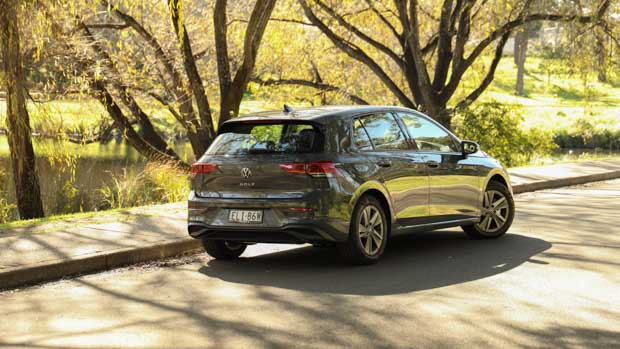
A cheerful six-speed manual is still available on this most affordable of eighth-gen Golfs, priced at $29,350 before on-road costs, while a new eight-speed auto will set you back $31,950 before on-roads.
By the time you drive out of the dealer, that makes the new Golf quite a bit more expensive than before – but Volkswagen has made a strong case to convince you it’s worth the new asking price.
As it has for many generations, the new Golf will appeal to many younger buyers, and in no grade is this more true than the base model.
Volkswagen have wisely focused its attention on safety by providing an extensive safety suite almost entirely standard across the range – save for a few extra technologies which are nice to have but not critical for most people.
Core features that really matter like advanced AEB with pedestrian and cyclist detection, adaptive cruise control, front and rear parking sensors are all present on the base model.
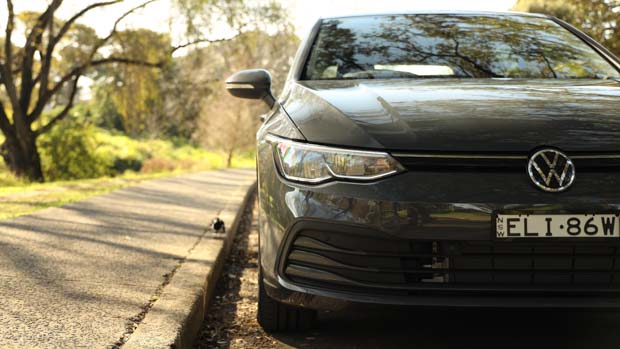
It’s important to note that rear AEB is standard on the base model Golf, which is a rare feature in this segment, and will be of particular interest to those with small and fast-moving children.
Safety might not excite as much as the Golf’s edgier new look, but a comprehensive suite will also give parents of older children peace of mind as they slot their P-plater into the front seat of the new Mk 8.
Buyers will be paying more for this safer new Golf, which retains a level of build quality few other brands can match – but Volkswagen can’t be caught napping in this latest generation.
Key rivals such as the Mazda 3, Toyota Corolla and the Hyundai i30 all present a strong package on a number of fronts and continue to resonate with Australian consumers despite tastes moving towards SUVs.
It’s with this in mind that the Golf enters a new generation and while it ticks the usual boxes it also falls well short in some important areas.
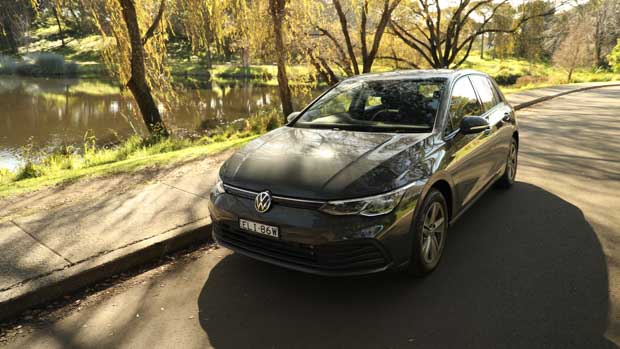
Much like the previous generation, the Mk 8 Golf achieves a commendable balance between athletic drying dynamics and a comfortable ride that is joyous to live with every day.
This combination sees the Golf shine the brightest where it is likely to spend the most time – threading through city streets and across torn-up suburban roads.
With accurate and well-weighted steering fed through a chunky steering wheel, the Golf feels easy to drive and park and with its compact dimensions making driving feel natural and easy.
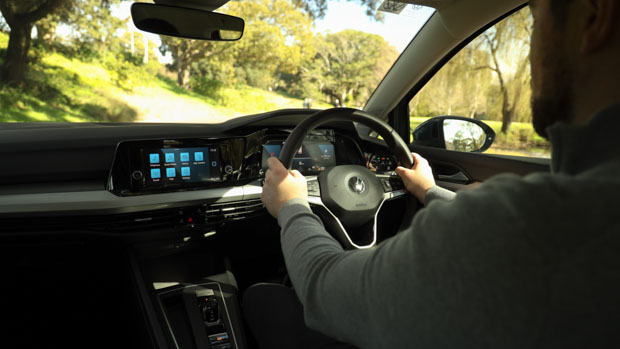
The handling is what truly sets the Golf apart from its rivals. Volkswagen has done well to keep the multi-link rear suspension, increasingly rare at this price, that brushes off bumps that would unsettle much larger and more expensive cars
We do this see arrangement on rivals such as the Toyota Corolla which also drive with spirit, but that dependable Japanese workhorse can’t match the Golf’s settled demeanour and superior body control.
The Golf remains flat unless truly challenged, and if you intend to max out this platform’s sporting attributes, you may prefer to look at the higher-spec Golf R-Line, which brings sportier damping to the fore, or the Golf GTI hot hatch.
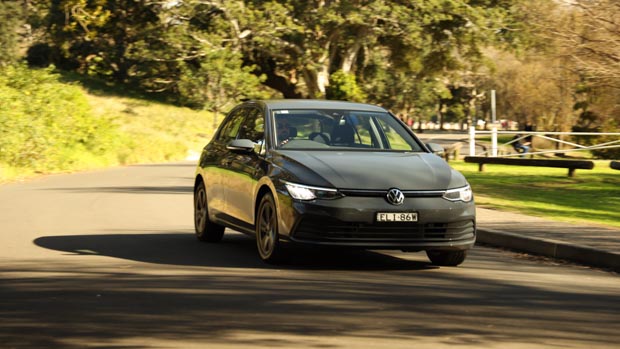
The feeling of calm actually made the little Golf deceptively fast, on one occasion I found myself rapidly approaching the rear end of a lumbering SUV on a twisty road only to look down at my speedometer in alarm.
The base model Golf wears a set of 16-inch wheels and chunkier tyres that results in a more comfortable ride than the mid-spec Golf Life with larger 17-inch wheels but the latter still provides a very smooth ride.
It’s considerably more comfortable than the Skoda Scala, which is similar in size and wears standard 18-inch wheels. Notably, the Scala does not have the ‘full’ version of the Golf’s MQB platform, instead running the Polo’s cheaper, simpler MQB-A0 architecture.
So, in some ways, you get what you pay for when you step up to the Golf.
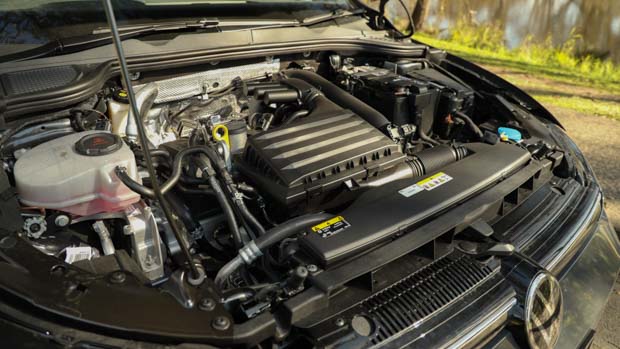
The ability to carry momentum means there is less demand on the 1.4L turbo petrol four-cylinder engine which carries over from the previous generation Golf, but that is by no means a bad thing.
With 110kW of power and 250Nm of torque, the 1.4-litre is one of the most powerful engines in its class and particularly when looking at the base models of rivals such as the Hyundai i30 which opts for a thirsty and underwhelming naturally aspirated 2.0L four-cylinder engine.
Volkswagen has fitted the eight-speed torque converter automatic to the Mk8 in place of the old but highly praised seven-speed dual-clutch DSG, a swap that seems to have done the Golf few favours.
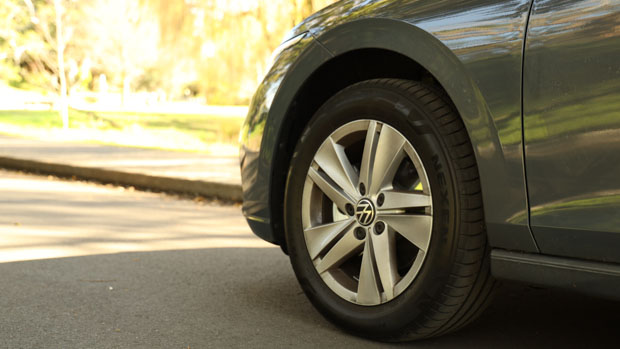
When setting off from a stop the gearbox often seems determined to hang onto first gear right to the end of the limiter, which on one occasion earned me a judgmental frown for an elderly dog walker as I slowly pulled out of a T-junction with more thrash than expected.
Problems arise again when coming to a stop at slow speeds, as the gearbox can be somewhat ‘lumpy’ as it shifts down through each gear.
That said, the automatic gearbox is by no means intolerable, and I found my driving style adapted to minimize these issues – but unlike some, we hope the well-tuned seven-speed dual-clutch DSG returns with a future facelift.
For this reason, it might be worth considering the six-speed manual option which is likely to be a lot more fun and with an extra $2,600 in your pocket, you’re getting the same Golf for a lot less money.
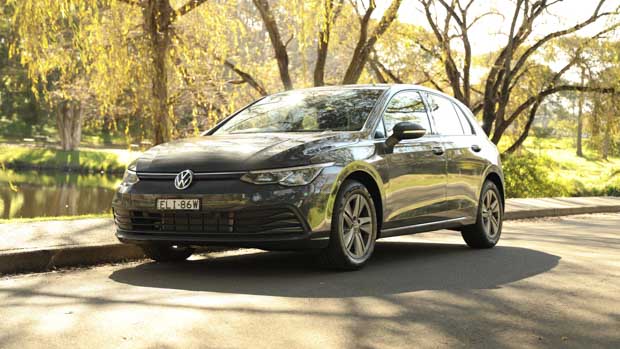
What struck us most about how the Golf drove was the sheer breadth of driving that it seemed to excel in, which was far more than you might expect for a car of this size and price.
Taking to a highway in most hatches is often a ‘focused’ exercise that even in modern cars requires careful attention as the skinny tyres hook into cracks and dart across the road or get blown about by passing trucks, but the Golf feels as stable as a car in a category above.
Volkswagen engineers have done well to make their hatch feel at home at 110km/h which feels solid and secure in high speed corners and provides a nice quiet cabin that will be a welcome gesture on long trips.
Pop on the adaptive cruise control and this peace of mind is enhanced further, which is better tuned than most but does remind you it is purely an ‘assistance program’ as the lane keeping somewhat struggles to detect road edges such as barriers from time to time.
With a new generation comes a need to tackle modern styling trends and you can tell the designers have focused intensely around this point.
The interior of the Mk8 Golf is minimalist, functional and does reflect a relatively high level of luxury in everything from the choice of soft materials on key touchpoints around the cabin to the satisfying ‘thunk’ of the door close – that will provide a reassuring moment for buyers that they have spent their money wisely every time they get in.
Space is ample in the front allowing passengers enough room to stretch out in all directions and make themselves comfortable in the supportive fabric seats.
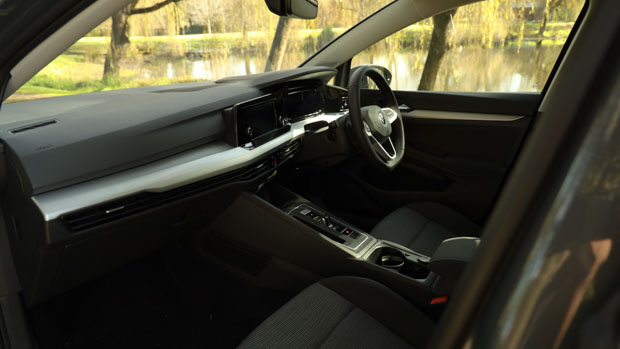
It’s a similar story in the rear which has plenty of room for adults and the fitment of three-zone climate control means rear occupants and the two front occupants can all choose a temperature of their liking – a feature which is quite rare for this class.
Rear occupants miss out on a centre armrest in the entry-level Golf, but you still do get other helpful touches like ISOFIX point on the outboard seats and a seat belt reminder for when the kids get a bit older.
A key omission from the base model Golf is the lack of standard floor mats which feels distinctly un-Volkswagen. It was also immediately annoying after a rainy day saw me transport the foliage of my street directly from ground-to-foot-to-cabin and was then far harder to get rid of than just shaking out a mat.
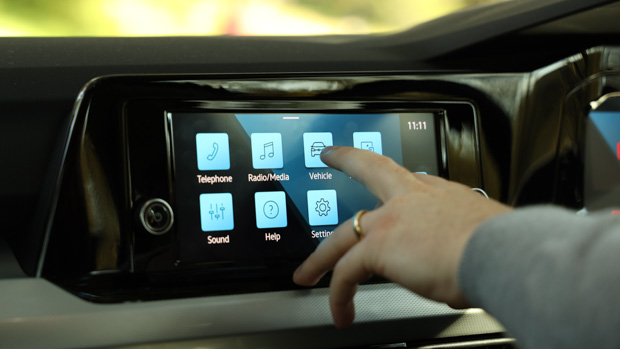
Buyers can add front and rear textile floor mats for $265.10 fitted or opt for a durable rubber version for $266.20 fitted – but mats are standard in the $2,300-dearer Golf Life that sits above the base car in the lineup.
You can fix the mat issue – but the same cannot be said for the new touchscreen interface.
Volkswagen has fitted the entry-level Golf with a 8.25-inch screen instead of the 10-inch version on higher grades, but both screens suffer from a laggy and overly complex interface – despite a veneer of simplicity. That said, the screens themselves are larger and higher resolution than those offered on older rivals like the Honda Civic.
The interface, though, is frustrating and difficult to use, at times far too slow to respond, while taps seem to miss their target, as if the underlying slate has not been properly tuned – meaning you sometimes have to take multiple stabs to achieve the desired response … while the car is moving.
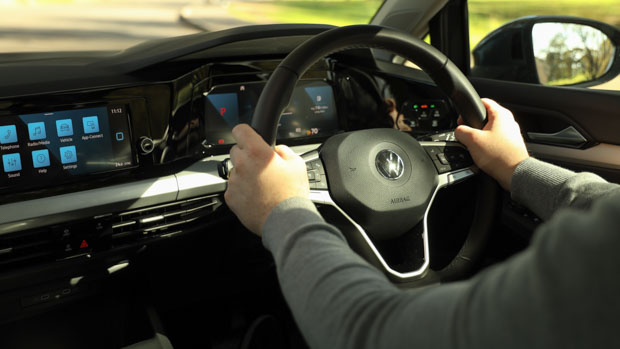
One feature we like is that the base Golf has proper knobs for volume and tuning, rather than the similarly frustrating sliders found on higher grades.
Thankfully, these issues can mostly be avoided by using the shortcut buttons on the steering wheel, which has a fantastic array of satisfying buttons to control multimedia.
Sitting in front of the driver is the fantastic 10.25-inch display that acts as the virtual cockpit in place of traditional dials. The digital screen is incredibly crisp and responsive but without any built-in navigation, its functionality is limited to simple readouts such as fuel consumption.
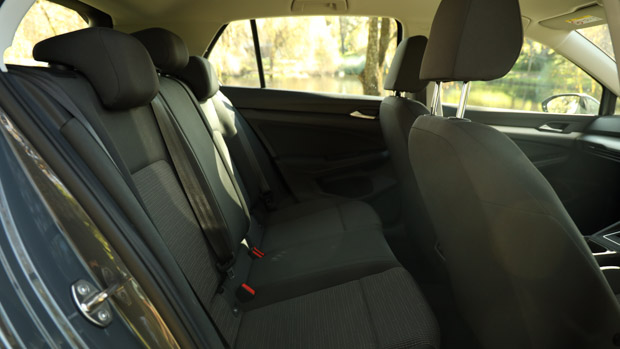
Volkswagen has reserved wireless charging and wireless Apple Carplay and Android Auto for the high trim levels, leaving entry-level buyers with a less convenient wired solution.
Once plugged into the array of USB-C charging ports, the Golf does provide phones with a quick charge, while audio quality is decent through the six-speaker stereo, which is rarely strained due to the Volkswagen’s ability to fend off road noise.
The backseats of the Golf are some of the most spacious in this class with ample headroom and legroom for my six-foot frame. A rear centre armrest is not included on the base grade but occupants still benefit from air vents and two USB C ports.
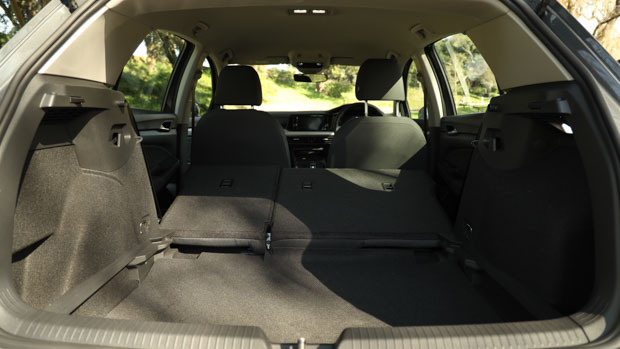
The boot of the Golf measures 381 litres which is a very minor increase over the previous generation but is significantly larger than many of its rivals, while retaining the space-saver spare.
But boot space is more than just about numbers and usability is where the Golf really shines, thanks to a wide opening and an adjustable floor height.
In my week with the Golf, I saw the boot swallow everything from the weekly shopping, odds and ends at Bunnings to transporting an entire cabinet without much strain – at least on the Golf’s behalf.
If you’re ready to accept the purchase price of the new Golf, then you’ll be pleased to know the ongoing costs of ownership are reasonably inexpensive from here on out.
Volkswagen offers a choice of two service packs costing either $1,200 to cover the first three years or $2,100 to cover five. The service intervals are annual or every 15,000km.
The service plans are said to save buyers between $191 and $803 compared with fronting up the cash every time you visit the mechanic, with the longer and more expensive plan offering the best value.
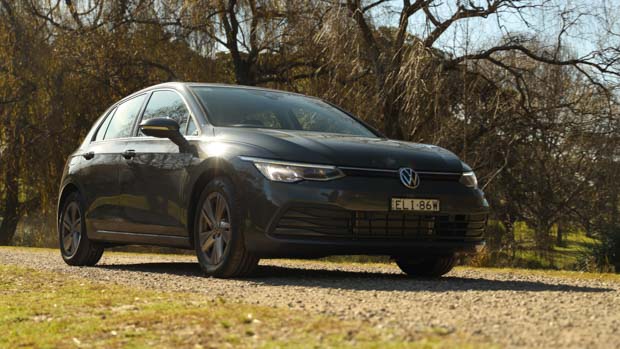
It’s worth noting that these packs can be transferred to a new owner so if you find yourself looking for a change in wheels you won’t be throwing money down the drain.
As with all Volkswagens, the Golf comes with a five-year, unlimited-kilometre warranty which is good but not the best in this class.
The 1.4L turbocharged engine is as fun as it is efficient, and while it didn’t reach its 5.8L/100km claim we still saw 7.1L/100km – but keep in mind you will need to use 95 octane fuel at a minimum.
The Volkswagen Golf is one of the most versatile and consistent cars ever built and that certainly hasn’t changed with the new eighth-generation version.
While the price of entry has jumped significantly, you are buying a well-rounded vehicle in base form – though we’d recommend grabbing a sharper deal by sticking to the six-speed manual if you can.
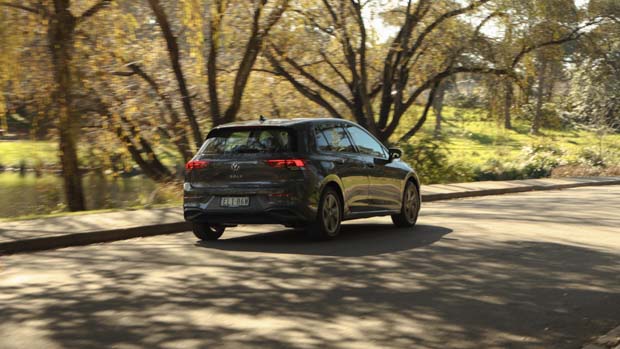
That said, spending just $2,300 more on the mid-tier Golf Life nets you a more complete vehicle from a features point-of-view, enhancing the base car’s solid fundamentals.
Volkswagen has been fairly criticized for the Golf’s sub-par infotainment system, and hopefully, software fixes should improve the responsiveness over time.
The Golf has a number of rivals worthy of consideration – but even with the latest car’s short list of foibles, no small car is as well-rounded as this one.
Key specs (as tested)
About Chasing cars
Chasing Cars reviews are 100% independent.
Because we are powered by Budget Direct Insurance, we don’t receive advertising or sales revenue from car manufacturers.
We’re truly independent – giving you Australia’s best car reviews.
The estimate provided does not take into account your personal circumstances but is intended to give a general indication of the cost of insurance, in order to obtain a complete quote, please visit www.budgetdirect.com.au. Estimate includes 15%^ online discount.
^Conditions Apply
Budget Direct Insurance arranged by Auto & General Services Pty Ltd ACN 003 617 909(AGS) AFSL 241 411, for and on behalf of the insurer, Auto & General Insurance Company Limited(ABN 42 111 586 353, AFSL 285 571).Because we don’t know your financial needs, we can’t advise you if this insurance will suit you. You should consider your needs and the Product Disclosure Statement before making a decision to buy insurance. Terms and conditions apply.
Indicative quote based on assumptions including postcode , 40 year old male with no offences, licence suspensions or claims in the last 5 years, a NCD Rating 1 and no younger drivers listed. White car, driven up to 10,000kms a year, unfinanced, with no modifications, factory options and/or non-standard accessories, private use only and garaged at night.
^Online Discounts Terms & Conditions
1. Discounts apply to the premium paid for a new Budget Direct Gold Comprehensive Car Insurance, Third Party Property Only or Third Party Property, Fire & Theft Insurance policy initiated online on or after 29 March 2017. Discounts do not apply to optional Roadside Assistance.
2. Discounts do not apply to any renewal offer of insurance.
3. Discounts only apply to the insurance portion of the premium. Discounts are applied before government charges, taxes, levies and fees, including instalment processing fees (as applicable). The full extent of discounts may therefore be impacted.
4. We reserve the right to change the offer without notice.